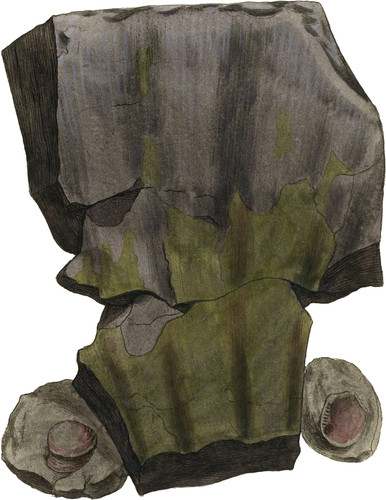 Enlarge
Enlarge
British Mineralogy
Pyritaceous or Alum Clay
- Class 2. Earths.
- Order 2. Mixed.
- Gen. 2. Farinaceous Quartz.
- Spec. Mixed with Argilla and Sulphuret of Iron.
- Syn.
- Pyrito-bituminous Aluminous Ore. Kirw. 2. 17.
- Argillaceous Schistus. Bab. 62.*
- Alum Slate. Jameson, 1. 323.
The Alum Clays vary much at the different places where they are found, and may be divided into many tolerably distinct varieties, from the appearance of common black Clay to a more slaty one, more or Jess indurated. They do not adhere to the tongue, nor take a polish readily by being rubbed with the finger nail, but rather a crumbly whitish streak. Aluminous Clay is sometimes glossy with a slaty fracture, but otherwise very dull, except baring some glistening particles of Pyrites.
Some sorts effloresce readily in the common air—see tab. 23 and 24—and some become covered with a whitish tasteless powder. The mixture, like other Clays, may contain many adventitious substances, particularly vegetable and animal. At Whitby*, Bolton and Stowbrow works, in Yorkshire, vegetable impressions, the remains of wood and various shells, are found in the Clay. I have very curious specimens of the different changes of vegetables, from Whitby, in petrifactions from bituminous coaly formations to the finest plank jet, if I may so term it, and some curious shelly remains, of which last sort are the Cornva ammonis—see tab. 30— which are commonly called Snake-stones; and to favour the idea, the people who gather them form one end into a kind of head.
Among the remains of shells, some there are almost all Pyrites; as the specimen now figured, from Whitby, being the remains of a large Pecten or Ostrea, is formed with two or three coats of Pyrites, I have therefore exhibited it for its novelty, as it will very well show the nature of the Clay at the same time. As I found a species of Arca, new to me, I add a figure, as I believe they are not uncommon there, though not, to my knowledge, elsewhere y therefore they may identify something of the geology of the spot, as well as add to our information in this department.
It somewhat depends on the nature of the ore to vary the means of obtaining the Alum from it. It is mostly burnt and well watered, and to the water, when saturated, is added Muriate of Potash, or some other Salt, sometimes an Ammoniacal Salt; it is then loft to crystallize, which the Alum usually does in masses terminated by four-sided pyramids. In the last act of crystallization it forms the other half of the octaëdron more or less perfectly with truncations, and sometimes crystals so piled on each other, side by side, that the workmen call them Alum towers, making handsome ornaments under a glass ; but these should not be exposed to the sun, nor to much warmth, as they will then lose their beautiful transparency.
The Alum stone of Tolfa† in Italy is found to contain
| By Klaproth. | By Vauquelin. | |
| Silica | 56.5 | 24.00 |
| Alumina | 19.0 | 43.92 |
| Potash | 4.0 | 3.08 |
| Sulphuric Acid | 16.5 | 25.00 |
| Water | 3.0 | 4.00 |
| 99.0 | 100.00 |
The Roman Alum is sometimes found in small crystals of a reddish cast, and is well known in shops. The British Alum ore is little else than Clay and Pyrites. Sometimes particles of Mica are found in it.
Clays, which seem too common almost to claim attention, whether mixed with the spoils of the most precious rocks, plants, or animals, or with more humble materials, are still enriched to serve some future purpose; and according to Shakespeare, at the worst, they may, like the noble dust of Alexander, still serve to close a bunghole, or, like “Imperial Cæsar, dead and turn’d to Clay, might stop a hole to keep the wind away.”
- * Babington’s specimen from Whitby appears from its colour to have been roasted.
- † This, as may be inferred from the analysis, requires no addition of Alkali to make it crystallize. It seems very different from the British.

